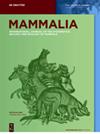啮齿动物对工业化地区食肉动物的重要性
IF 0.8
4区 生物学
Q3 ZOOLOGY
引用次数: 0
摘要
专业食肉动物往往是最先从人类主导的改造景观中消失的物种。然而,有些食肉动物物种可以在人类主导的景观中利用丰富的食物来源。在这项研究中,我们调查了栖息在南非姆普马兰加省高地石化厂周围人工和自然景观中的食肉动物--薮猫(Leptailurus serval)的饮食情况。从 2013 年到 2018 年,我们每年共收集并分析了 264 份粪便样本。我们发现,啮齿类动物是薮猫的主要食物,而鸟类、昆虫和不明猎物等其他猎物对薮猫的食物贡献不大。就消耗的生物量而言,啮齿目啮齿动物(56.94%)、啮齿目啮齿动物(19.12%)和啮齿目啮齿动物(8.68%)是最重要的啮齿目猎物。我们还发现,生物量的消耗只受物种的影响,而不受季节或物种-季节相互作用的影响。我们的研究结果与之前的研究结果一致,即薮猫主要是啮齿类动物专家,即使在人类改变的地貌中也是如此。本文章由计算机程序翻译,如有差异,请以英文原文为准。
The importance of rodents to a specialist carnivore in an industrialized site
Specialist carnivores are often among the first species disappearing from transformed, human-dominated landscapes. However, some carnivore species can exploit abundant food sources in human-dominated landscapes. In this study, we investigated the diet of a specialist carnivore, the serval (Leptailurus serval ), inhabiting artificial and natural landscapes surrounding a petrochemical plant in the Highveld of Mpumalanga, South Africa. From 2013 to 2018, for each year, we collected and analysed a total of 264 scat samples. We found that rodent species dominated the serval diet, while other prey items like birds, insects, and unidentified prey contributed little to the diet. In terms of biomass consumed, Otomys sp (56.94 %), Mastomys sp (19.12 %), and Rhabdomys sp (8.68 %) were the most important rodent prey. We further found that biomass consumed is only affected by species, not season or species–season interactions. Our results concur with previous studies that serval is primarily a rodent specialist and that specialisation holds even in human-altered landscapes.
求助全文
通过发布文献求助,成功后即可免费获取论文全文。
去求助
来源期刊

Mammalia
生物-动物学
CiteScore
2.20
自引率
10.00%
发文量
68
审稿时长
6-12 weeks
期刊介绍:
Mammalia is an international, multidisciplinary, bimonthly journal devoted to the inventory, analysis and interpretation of mammalian diversity. It publishes original results on all aspects of the systematics and biology of mammals with a strong focus on ecology, including biodiversity analyses, distribution habitats, diet, predator-prey relationships, competition, community analyses and conservation of mammals. The journal also accepts submissions on sub-fossil or recently extinct mammals.
 求助内容:
求助内容: 应助结果提醒方式:
应助结果提醒方式:


